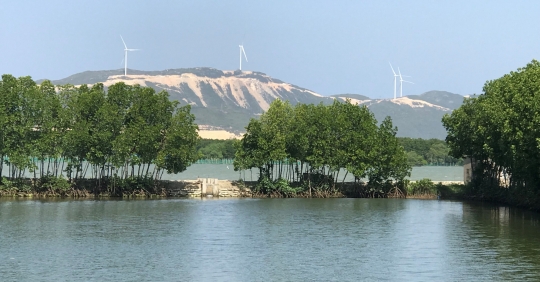Green tourism from mangroves
Not to mention that the ecological area of Con Chim – Thi Nai Lagoon in Tuy Phuoc district (Binh Dinh) has now become a very attractive tourist destination. The square crab ponds, with the green color of the mangrove forests, brought the birds to life here, especially in the late afternoon, the storks gather in flocks, making Con Chim an “ecological pearl island” that no tourist wants to miss it every time they have the opportunity to return to Binh Dinh.
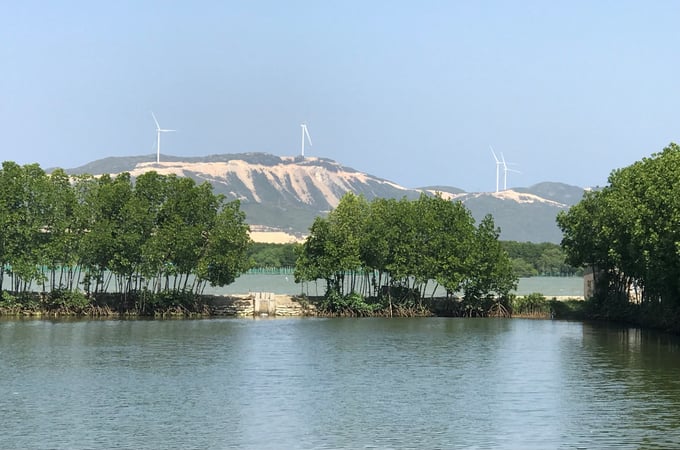
The square shrimp ponds are intertwined with the mangrove forest, the green color of the forest mixed with the blue of the sky and water is very attractive to tourists. Picture: VDT
According to Mr. Tran Van Thanh, Director of the Ministry of Culture, Sports and Tourism in Binh Dinh, the Con Chim Oasis has great potential for ecotourism development due to the strength of its pristine river-like landscape in the southwest region. Especially when the sunset falls, many birds fly here to create a peaceful space, the products here are also very rich; Shrimp, crabs and fish are raised in ponds. If Con Chim becomes operational for tourism, it will bode well for Binh Dinh’s tourism industry to have an attractive travel destination, and at the same time, this service will improve the living standards of local people.
In the past, the District People’s Committee recognized Con Chim’s tourism development potential
Tuy Phuoc has partnered with Ton Duc Thang University (HCMC) to set up a homestay tourism pilot here. The expectation of the Tuy Phuoc District leaders and functional authorities of the homestay tourism model is to combine the most effective use of the potential and advantages of the mangrove area, coupled with aquaculture, and gradually create more livelihoods for the people of the river step towards realizing the goal of local tourism development.
Although he works in agriculture, Mr. Truong Xuan Dua, Head of Agricultural Technology Research and Application Station of Binh Dinh Agricultural Extension Center, has a vision of “green tourism” not only in Con Chim, but also in many areas of integrated aquaculture with drawn shrimp – crab – fish in Binh Dinh.
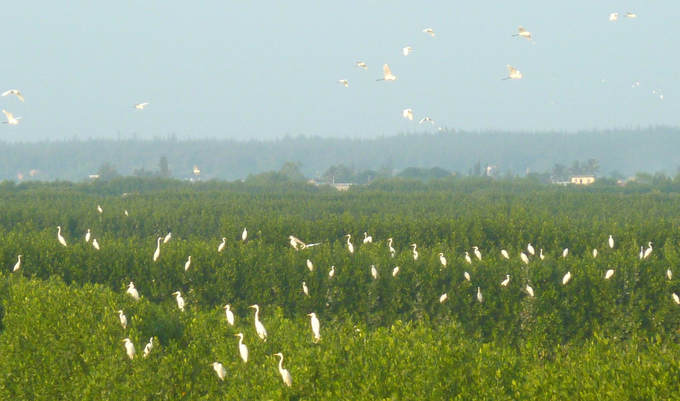
Mangroves lure the birds of the sky to life, and in the late afternoon storks flock in droves, helping Con Chim become an “ecological pearl island”. Picture: VDT
According to Mr. Dua, the shrimp farming areas using the shrimp crab fish farming method in Binh Dinh are all river areas, in addition to the areas that have been covered with mangrove forests that have ponds in the integrated aquaculture area By planting mangrove trees around the pond is the space covered with green trees, water and sky.
Tourists ride boats to enjoy the scenery of the river, watch the birds in the sky, return to the shrimp ponds to continue experiencing how nets are dropped to catch aquatic life, and then grill shrimp by the fire, too fishing, stewing crabs in the shade of mangroves, cork trees is none of that.
“In addition, the areas where shrimp are farmed between crab and wild fish also have the opportunity to develop clean shrimp products, ecological shrimp and brand registrations, as Ca Mau has done a lot. If so, the tourism industry in Binh Dinh will take a new direction, shrimp farmers in the lower areas will have more opportunities to increase their income,” said Truong Xuan Dua.
Pollution threatens aquaculture areas
The potential of eco-tourism and “green tourism” of the natural aquatic aquaculture areas in Binh Dinh is great, but to become a reality, the functional branches of this province still have work to do.
According to MSc Ta Xuan Hoai, Ton Duc Thang University, Binh Dinh’s current problem is to inform tourists about Con Chim, so that visitors know that when they come here, they will live in an ecological environment and breathe fresh air a tranquil green space and a dining experience. Definitely Binh Dinh must let visitors know that this place is stopover place with good service.
However, Nguyen Dinh Thanh, head of the Department of Social Research (Institute for Socio-Economic Development Research of Binh Dinh Province), the current rate of urbanization in the lagoon areas has disrupted many ecologies and severely affected the mangrove areas. In the long term, the authorities and functional sectors in Binh Dinh must recognize this problem to make reasonable calculations in planning to avoid injuring the “lungs” of Binh Dinh area and depriving many areas of benefits. Residents can develop eco-tourism to avoid later regrets.
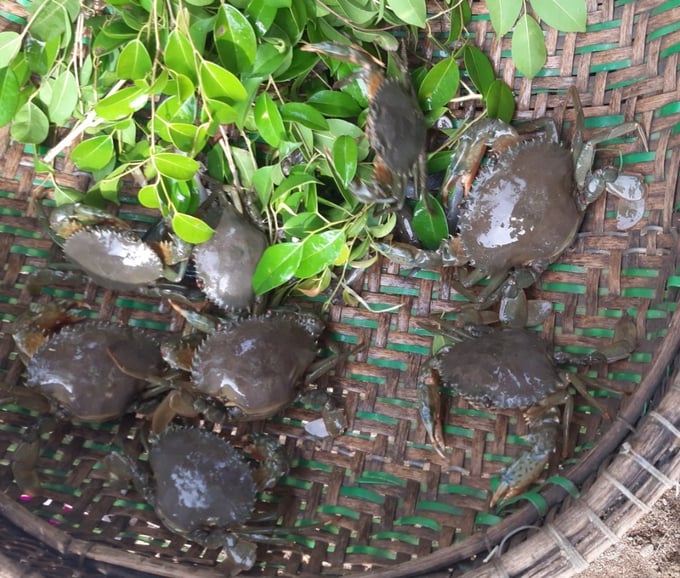
Visitors to the aquaculture areas under the mangroves can also experience the cuisine, catching and processing the food themselves. Picture: VDT
The current bottleneck in the development of ecotourism in the integrated aquaculture areas in Binh Dinh mangroves is that the downstream environment is seriously threatened by pollution from the upstream area. This pollution not only harms the aquaculture of the people here, but also disrupts the ecological environment of the entire region.
The habit of farmers in the upstream areas often throws agricultural waste into rivers and streams, the biggest concern is the packaging of crop protection products. Not to mention the animals that died from the disease, which were also discharged into canals, rivers and streams. When it rains heavily, all of the above wastes are pushed to downstream areas, smuggled into shrimp farming areas, harming aquatic life in ponds, and polluting rivers.
To overcome this situation, the natural resources and environment sectors, the agricultural sector and local authorities and people must work closely together to prevent it. Waste must be treated at source to reduce pollution downstream. Otherwise, integrated aquaculture will be in dire straits under conditions directly influenced by tidal waters.
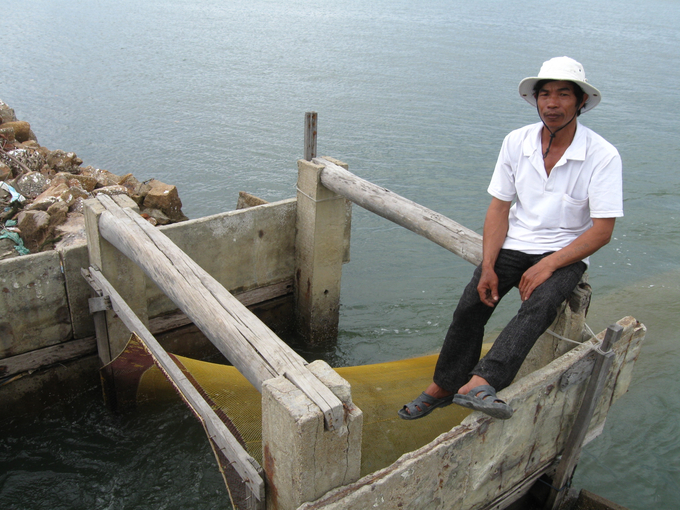
In the past 2 years, the integrated aquaculture area under the dike in Binh Dinh has flooded the gate frequently due to the influence of climate change. Picture: VDT
Typical of this concern may be Huynh Gian Nam village in Phuoc Hoa commune (Tuy Phuoc district) where it is known as “garbage bag” pouring from upstream and this place needs cleaning.
According to Huynh Gian Nam Village MP Mr. Nguyen Van Chin, the traffic in the shrimp farming areas is very narrow dirt roads, local people need to mobilize people to use garbage trucks and turtles to collect garbage for treatment to clean up the waste to reduce and minimize water pollution for shrimp farming.
“Upstream, when there is little rain in April-May, say nothing. During the months of the rainy season, dirty water rushes down from the source, carrying residues of pesticides from agricultural production into the aquaculture ponds Pond water level only 2.4m high, when the flood water comes back, the water level in the lagoon rises to 2.6-2.7m high. Garbage from upstream follows the flood water and pollutes the huge water area,” lamented Vo Van Thanh, a general Aquaculture farmer in Binh Thoi Village, Phuoc Thuan Township (Tuy Phuoc District).
“In the past 15 years, flood waters have never flooded the gate, but in the past 2 years, flood waters have flooded the gate due to the impact of climate change. The gate is 8-8 feet high but not much, when I open the door late at night I can’t see the gate because the water is flooded. Sometimes it is forecast that the tide will rise only 2.1m, but actually the water rises to 2.4-2.5m, the water is unsafe, which affects the aquaculture farmers in the agricultural areas under the dike where it is directly affected water is causing trouble,” said Mr. Vo Van Thanh, who farms shrimp – crab – fish in the low-lying area of Phuoc Thuan Township (Tuy Phuoc District).

